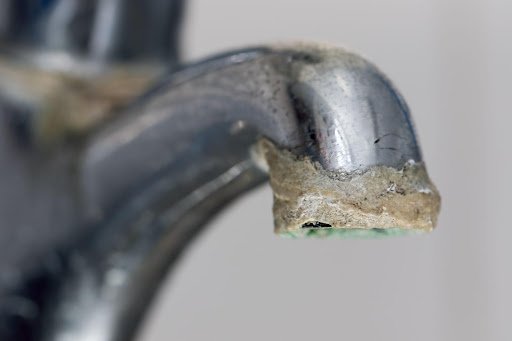Calcium buildup — also known as limescale — is a result of water that contains dissolved calcium salts flowing through your pipes and out your faucets and showerheads. Water with high levels of these calcium salts and other minerals is referred to as “hard water.” If your hard water has high iron content, the buildup can appear rusty or yellow, with the potential to stain your sink or bathtub and impact the sink’s water pressure.
While higher amounts of certain minerals don’t mean your water supply is not safe for consumption or regular household use, it can still take a toll on metal items; meaning your faucets, metal pipes, and appliances can be corrupted by repetitive exposure to calcium and magnesium.
How Can I Remove Calcium Buildup On My Faucets?
Mineral deposits on faucets can be removed with a few household items. You will need:
- White vinegar
- A soft rag or paper towels
- Rubber bands
- Sponge or textured cloth
Begin by soaking the rag strips or paper towels in the white vinegar. Then, wrap the material around the areas covered in buildup, securing with rubber bands where necessary. You may choose to secure a plastic bag to the fixture, as well. You should allow these areas to soak for an hour.
Next, remove the rags and use the wet cloth or sponge to remove any remaining buildup, which will have been softened from the vinegar soak. The rough side of a kitchen sponge can make this part of the job easier. When all the buildup is removed, dry the area thoroughly with a clean towel.
Alternatives for Tackling Mineral Buildup
- Chemicals: Wipe down the faucet with a wet cloth and all-purpose cleaner. Dish detergent will also work. Focus on scrubbing under and in back of the fixture and anywhere else water accumulates. Rinse the sink and wipe any remaining residue dry.
- Lemons or lemon juice: Take a lemon wedge to the calcium buildup. The citric acid will help dissolve the calcium minerals stuck on chrome, copper, or brass. Then, rinse the sink out and dry the faucet.
- Remove the faucet aerator: Unscrew the aerator — the small filter on the edge of your faucet with a screen — and use a toothbrush or other small brush to scrub off calcium buildup from the inside. Then, place it in a bowl with vinegar for an hour and dry it prior to screwing it back on.
If you’re tired of dealing with calcium deposits, turn to trusted professionals! Our plumbing experts can consult you on the best options to meet your home’s unique plumbing needs. For more help in keeping your faucets free of calcium carbonate buildup with our suite of plumbing services, including pipe replacement services, reach out to us today.

